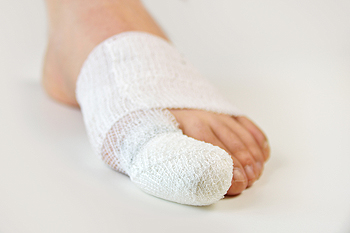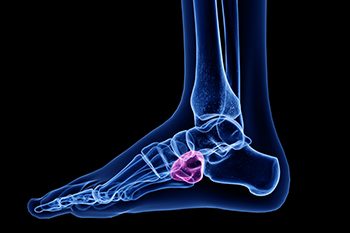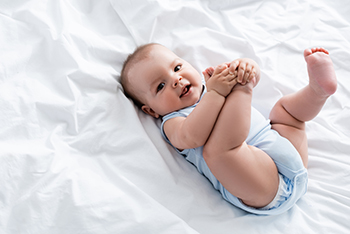Items filtered by date: July 2022
Reducing and Recovering From Sports Injuries of the Toe

While toe injuries are usually not serious, they can seriously impede the progress of an athlete. If you participate in sports, it is critical that you wear the right shoes for the sport that you participate in. Watch for toe fractures by tending to the severity of the pain felt and possible swelling, looking for deformities of the toe or toenail and other possible wounds. If a toe is sprained and not broken, it can be buddy taped to the toe next to it to reduce pain and speed recovery. Doing some basic motion exercises might also help with blood flow, and reduce pain and stiffness. Toe injuries left untreated or unaddressed for too long could lead to stiffness, arthritis, or permanent pain long-term. Toe injuries sustained during sports that involve fractures or do not heal after resting for a period of time should be seen by a podiatrist for proper diagnosis and guidance in treatment.
Ankle and foot injuries are common among athletes and in many sports. They can be caused by several problems and may be potentially serious. If you are feeling pain or think you were injured in a sporting event or when exercising, consult with Dr. Douglas Mckay from New Jersey . Our doctor will assess your condition and provide you with quality foot and ankle treatment.
Common Injuries
The most common injuries that occur in sporting activities include:
- Achilles Tendonitis
- Achilles Tendon Rupture
- Ankle Sprains
- Broken Foot
- Plantar Fasciitis
- Stress Fractures
- Turf Toe
Symptoms
Symptoms vary depending upon the injury and in some cases, there may be no symptoms at all. However, in most cases, some form of symptom is experienced. Pain, aching, burning, bruising, tenderness, tightness or stiffness, sensation loss, difficulty moving, and swelling are the most common symptoms.
Treatment
Just as symptoms vary depending upon the injury, so do treatment options. A common treatment method is known as the RICE method. This method involves rest, applying ice, compression and elevating the afflicted foot or ankle. If the injury appears to be more serious, surgery might be required, such as arthroscopic or reconstructive surgery. Lastly, rehabilitation or therapy might be needed to gain full functionality in the afflicted area. Any discomfort experienced by an athlete must be evaluated by a licensed, reputable medical professional.
If you have any questions, please feel free to contact one of our offices located in Caldwell, and Galloway, NJ . We offer the newest diagnostic and treatment technologies for all your foot care needs.
Symptoms of Cuboid Syndrome

One common foot affliction that can cause serious pain is known as cuboid syndrome. This condition causes pain primarily on the outer area of the foot, termed lateral foot pain. Cuboid syndrome occurs when the cuboid bone, a particularly small bone on the outside of the foot, dislocates. This dislocation can be caused either by ankle sprains or repeated trauma on the peroneus longus muscle. There are a number of symptoms that you may experience when you develop cuboid syndrome. In addition to lateral foot pain, you may notice yourself limping when you walk. Limping is common for people experiencing cuboid syndrome, because it indicates that the person is attempting to avoid walking on the cuboid bone. In addition, those suffering from cuboid syndrome might experience swelling and tenderness in the dislocated bone. Although symptoms can vary from patient to patient, you might also experience a feeling of weakness in the entire foot. This weakness can be most pronounced when beginning to jump or run. Cuboid syndrome can detrimentally affect the health of your feet and your lifestyle. It is suggested that you seek the help of a podiatrist to mitigate the pain and treat the condition.
Cuboid syndrome, also known as cuboid subluxation, occurs when the joints and ligaments near the cuboid bone in the foot become torn. If you have cuboid syndrome, consult with Dr. Douglas Mckay from New Jersey . Our doctor will assess your condition and provide you with quality foot and ankle treatment.
Cuboid syndrome is a common cause of lateral foot pain, which is pain on the outside of the foot. The condition may happen suddenly due to an ankle sprain, or it may develop slowly overtime from repetitive tension through the bone and surrounding structures.
Causes
The most common causes of cuboid syndrome include:
- Injury – The most common cause of this ailment is an ankle sprain.
- Repetitive Strain – Tension placed through the peroneus longus muscle from repetitive activities such as jumping and running may cause excessive traction on the bone causing it to sublux.
- Altered Foot Biomechanics – Most people suffering from cuboid subluxation have flat feet.
Symptoms
A common symptom of cuboid syndrome is pain along the outside of the foot which can be felt in the ankle and toes. This pain may create walking difficulties and may cause those with the condition to walk with a limp.
Diagnosis
Diagnosis of cuboid syndrome is often difficult, and it is often misdiagnosed. X-rays, MRIs and CT scans often fail to properly show the cuboid subluxation. Although there isn’t a specific test used to diagnose cuboid syndrome, your podiatrist will usually check if pain is felt while pressing firmly on the cuboid bone of your foot.
Treatment
Just as the range of causes varies widely, so do treatments. Some more common treatments are ice therapy, rest, exercise, taping, and orthotics.
If you have any questions, please feel free to contact one of our offices located in Caldwell, and Galloway, NJ . We offer the newest diagnostic and treatment technologies for all your foot care needs.
Facts About Capsulitis of the Second Toe

The foot has 30 ligaments, five of which connect the long bones of the midfoot (metatarsals) to the toes (phalanges). The ligaments form a capsule around the joint, helping it to work properly when you walk, run, or jump. When such a ligament becomes inflamed, it causes a pain called capsulitis. The most common form of this condition occurs in the second toe, often the result of a bunion, a longer second toe, flat feet, or low arches. It is sometimes mistaken for Morton’s neuroma, but that is a separate condition that affects the nerves. Capsulitis of the second toe is progressive and worsens over time, usually because of genetics or overuse. Long-term wearing of high heels may also have contributed to this. A podiatrist can examine your foot to detect the source of the pain using an X-ray and manipulation of the affected area. Conservative treatments, such as ice, rest, medication, and orthotics may be recommended. Changing footwear, taping, and splinting can also help. If these methods are not effective, or if your condition is particularly advanced, surgery may be another option.
Toe pain can disrupt your daily activities. If you have any concerns, contact Dr. Douglas Mckay of New Jersey . Our doctor can provide the care you need to keep you pain-free and on your feet.
What Causes Toe Pain?
Most severe toe pain is caused due to a sports injury, trauma from dropping something heavy on the toe, or bumping into something rigid. Other problems can develop over time for various reasons.
Toe pain can be caused by one or more ailments. The most common include:
- Trauma
- Sports injury
- Wearing shoes that are too tight
- Arthritis
- Gout
- Corns and calluses
- Hammertoe
- Bunions
- Blisters
- Ingrown toenails
- Sprains
- Fractures (broken bones)
- Dislocations
When to See a Podiatrist
- Severe pain
- Persistent pain that lasts more than a week
- Signs of infection
- Continued swelling
- Pain that prevents walking
Diagnosis
In many cases the cause of toe pain is obvious, but in others, a podiatrist may want to use more advanced methods to determine the problem. These can range from simple visual inspections and sensation tests to X-rays and MRI scans. Prior medical history, family medical history, and any recent physical traumatic events will all be taken into consideration for a proper diagnosis.
Treatment
Treatments for toe pain and injuries vary and may include shoe inserts, padding, taping, medicines, injections, and in some cases, surgery. If you believe that you have broken a toe, please see a podiatrist as soon as possible.
If you have any questions please feel free to contact one of our offices located in Caldwell, and Galloway, NJ . We offer the newest diagnostic tools and technology to treat your foot and ankle needs.
Children Shoes for Different Stages of Foot Development
 The importance of taking care of babies' feet is crucial to having a strong foundation. Proper foot care started at an early age may help to ensure healthy feet. This can begin by refraining from having children wear shoes while indoors. The toes will grip the floor and this is beneficial in strengthening the overall foot. When the time comes to walk outside, shoes that are lightweight and flexible may be best and can act as protective skin. When a baby starts to walk the foot structure is beginning to develop. Flat feet that most babies are born with may start to diminish and the arch may be seen. The arch will continue to develop through the teenage years. As the baby grows, a sturdier shoe with some flexibility may be desired that can accommodate running and daily wear and tear. When purchasing shoes for your child it is suggested that their feet are properly measured and this is generally done every three months up to the age of three years. If you would like more information about babies' feet and how to properly care for them, please confer with a podiatrist.
The importance of taking care of babies' feet is crucial to having a strong foundation. Proper foot care started at an early age may help to ensure healthy feet. This can begin by refraining from having children wear shoes while indoors. The toes will grip the floor and this is beneficial in strengthening the overall foot. When the time comes to walk outside, shoes that are lightweight and flexible may be best and can act as protective skin. When a baby starts to walk the foot structure is beginning to develop. Flat feet that most babies are born with may start to diminish and the arch may be seen. The arch will continue to develop through the teenage years. As the baby grows, a sturdier shoe with some flexibility may be desired that can accommodate running and daily wear and tear. When purchasing shoes for your child it is suggested that their feet are properly measured and this is generally done every three months up to the age of three years. If you would like more information about babies' feet and how to properly care for them, please confer with a podiatrist.
Making sure that your children maintain good foot health is very important as they grow. If you have any questions, contact Dr. Douglas Mckay of New Jersey . Our doctor can provide the care you need to keep you pain-free and on your feet.
Keeping Children's Feet Healthy
Having healthy feet during childhood can help prevent medical problems later in life, namely in the back and legs. As children grow, their feet require different types of care. Here are some things to consider...
Although babies do not walk yet, it is still very important to take care of their feet.
Avoid putting tight shoes or socks on his or her feet.
Allow the baby to stretch and kick his or her feet to feel comfortable.
As a toddler, kids are now on the move and begin to develop differently. At this age, toddlers are getting a feel for walking, so don’t be alarmed if your toddler is unsteady or ‘walks funny’.
As your child gets older, it is important to teach them how to take care of their feet.
Show them proper hygiene to prevent infections such as fungus.
Be watchful for any pain or injury.
Have all injuries checked by a doctor as soon as possible.
Comfortable, protective shoes should always be worn, especially at play.
If you have any questions please feel free to contact one of our offices located in Caldwell, and Galloway, NJ . We offer the newest diagnostic and treatment technologies for all your foot and ankle needs.


